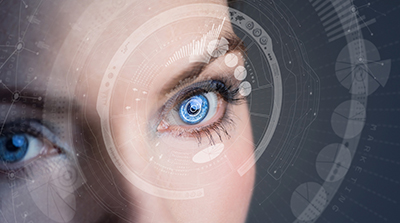Blog
The Future of Smart Contact Lenses: How This Embedded Vision Technology Works
Share This On X:
Smart contact lenses will bring advanced technology to what was once a simple, yet intricate design. The first contact lens invented in the late-1800s was manufactured from glass and fitted to cover the entire eye. It wasn’t until about half a century later that contact lenses were made from plastic. They’ll soon take another leap forward.
Applications for Smart Contact Lenses
 Contact lenses will soon leverage embedded vision technology to incorporate features that would have seemed like science fiction not too long ago.
Contact lenses will soon leverage embedded vision technology to incorporate features that would have seemed like science fiction not too long ago.
Blood Sugar Monitoring
Smart contacts will likely be able to monitor the blood sugar levels of diabetics by measuring the glucose in the user’s tears. Diabetics will finally be able to ditch the daily finger prick test.
Eye Medication Contacts
Researchers have created contact lenses that can deliver medication directly to the eye over days or weeks. This will let doctors treat glaucoma or prescribe contacts that help the user recover from eye surgery. Wearers would find it far easier to wear the contact instead of remembering to use eye drops.
Vision Correction
Today’s contact lenses offer vision correction, but many glasses wearers use bifocals or progressive lenses. Smart contact lenses can automatically adjust to help the user see up-close and far away. No more lines in their vision. No need to turn one’s head to see at different distances.
The Future of Smart Contact Lenses
It may be possible one day to provide smart vision to the wearer. They could learn instant information about people or objects just by looking at them. The user could have embedded vision built-in all the time. With a connection to the internet, there would be no limit to the information that could be provided via an augmented reality interface.
Users could even see in the dark. This technology could use a single layer of carbon atoms, called graphene, to pick up the full spectrum of light, including ultraviolet light. Or a wearer could zoom in on objects by looking at them. A nice feature of the smart contact lens is that no surgery is necessary to connect the user, and it could be easily inserted or removed by the user.
Challenges for Smart Contact Lenses
Some challenges will need to be overcome when building advanced smart contact lenses:
- A screen must be built that’s wireless and connects to a mobile device for contact lenses that can provide information by simply looking at an object
- To create the results needed to mimic a computer screen when looking through the smart contact lens, one million pixels are needed
- The contact lenses need to be wearable, breathable, see-through, and safe
Developers believe they’ve found solutions to these challenges. A self-assembly technique could be used where manufacturers take a liquid containing thousands of free-floating pixels, sandwich a circuit board between two pieces of glass and then pour the liquid in between the glass so the pixels stick to the metal on the circuit board. If all goes well, a real bionic lens could soon be on the market.
Recent Posts
- Automate Logistics Processes with K.Hartwall’s A-MATE™ AGVs
- Unlocking Potential: How the CHIPS Act Fuels Semiconductor Expansion for Automation and Beyond
- Looking at the Latest Machine Vision Standards Updates
- Insights into Robotics & Automation Investment Trends Emerging in 2024
- Hyperspectral and Multispectral Remote Sensing in Industrial Automation
- Powering Precision: Smart Linear Motors in Industrial Automation
- View All



